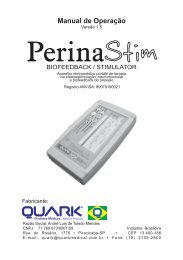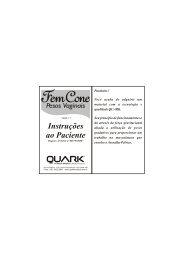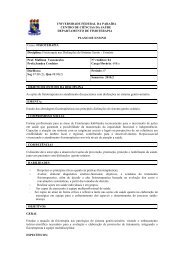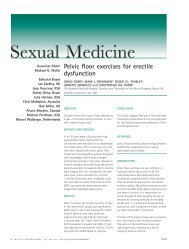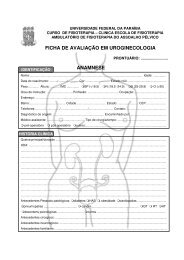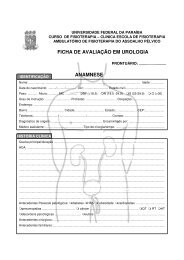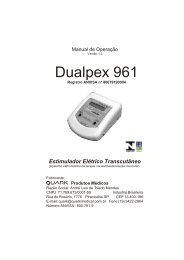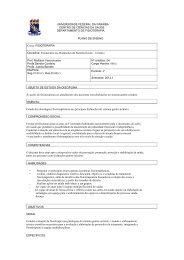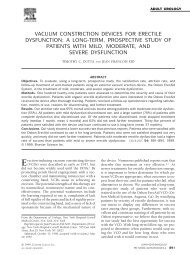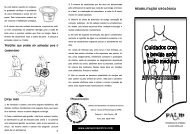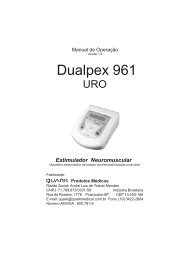Sacral neuromodulation for the treatment of refractory urinary urge ...
Sacral neuromodulation for the treatment of refractory urinary urge ...
Sacral neuromodulation for the treatment of refractory urinary urge ...
You also want an ePaper? Increase the reach of your titles
YUMPU automatically turns print PDFs into web optimized ePapers that Google loves.
2086 Sherman et al<br />
Table II Comparison <strong>of</strong> surgical, incontinence, and urodynamic<br />
parameters between younger and older respondents<br />
Young Older<br />
responders responders P-<br />
Measurements N (%) (%) value<br />
Time since incontinence<br />
s<strong>urge</strong>ry (O4 y)<br />
20 25.0 33.3 .69<br />
Pelvic floor muscle %2 20 37.5 41.6 .85<br />
Prepad weight (g) O400 20 50.0 50.0 .99<br />
Incontinence episodes<br />
(no.) O5<br />
20 12.5 66.7 .02<br />
Pads/day (no.) R5 20 62.5 50.0 .58<br />
Void volume (mL) R150 20 75.0 75.0 .99<br />
Frequency (no. voids/<br />
day) O10<br />
20 50.0 50.0 .99<br />
Pdet@Qmax<br />
(cm H2O) O20<br />
9 60.0 50.0 .76<br />
Flow rate (mL/s) !12 11 57.1 50.0 .99<br />
Presence <strong>of</strong> detrusor<br />
overactivity<br />
19 71.4 50.0 .36<br />
Pdet@Qmax, Detrusor pressure (cm H2O) at maximum flow (mL/<br />
second).<br />
Table III Comparison <strong>of</strong> surgical, incontinence, and urodynamic<br />
measurements <strong>for</strong> older respondents and nonrespondents<br />
Older Older non<br />
responders responders P-<br />
Measurements N (%) (%) value<br />
Time since incontinence<br />
s<strong>urge</strong>ry (O4 y)<br />
21 15.4 62.5 .03<br />
Pelvic floor muscle %2 21 15.4 62.4 .03<br />
Prepad weight (g) O400 21 38.5 75.0 .10<br />
IE/day (no.) O5 21 61.5 50.0 .60<br />
Pads/day (no.) R5 21 69.2 25.0 .05<br />
Void volume (mL) R150 20 50.0 87.5 .09<br />
Frequency (no.<br />
voids/day) O10<br />
20 50.0 37.5 .58<br />
Pdet@Qmax<br />
(cm H2O) O20<br />
11 50.0 80.0 .30<br />
Flow rate (mL/s) !12 11 60.0 33.3 .38<br />
Presence <strong>of</strong> detrusor<br />
overactivity<br />
21 69.2 62.5 .75<br />
retention is believed to be due to a primary failure <strong>of</strong><br />
relaxation <strong>of</strong> <strong>the</strong> striated urethral sphincter. 19,23 The<br />
mechanism <strong>of</strong> action <strong>for</strong> <strong>neuromodulation</strong> in retention<br />
patients is believed to be an activation <strong>of</strong> somatic<br />
afferent axons in <strong>the</strong> sacral spinal roots causing an<br />
inhibition <strong>of</strong> reflex pathways to <strong>the</strong> urethral outlet. This<br />
ultimately relieves pelvic floor spasticity, releasing <strong>the</strong><br />
detrusor from inhibition to allow <strong>for</strong> spontaneous<br />
voiding. 24<br />
Table IV Nonrespondent rates <strong>for</strong> age and pelvic muscle<br />
floor measurements<br />
Percentage<br />
Factor<br />
nonresponse<br />
Age alone<br />
O55 y 48% nonresponse<br />
PFM alone<br />
PFM = 0 or 1 80% nonresponse<br />
PFM %2 50% nonresponse<br />
Age and PFM in combination<br />
PFM = 0 or 1 and Age O55 y 100% nonresponse<br />
PFM %2 and Age O55 y 71% nonresponse<br />
PFM, Pelvic floor measurement.<br />
In this study, <strong>the</strong> overall response to sacral <strong>neuromodulation</strong><br />
is similar to that which is reported by o<strong>the</strong>r<br />
groups treating <strong>refractory</strong> idiopathic <strong>urge</strong> incontinence<br />
with <strong>neuromodulation</strong>. 22 There are no pretest stimulation<br />
urodynamic variables to predict success <strong>of</strong> sacral<br />
<strong>neuromodulation</strong> and similarly in this cohort no urodynamic<br />
variables seemed predictative <strong>of</strong> success. This<br />
study duplicates our earlier results, specifically, that<br />
younger women responded better to sacral <strong>neuromodulation</strong>.<br />
7 In addition, <strong>the</strong> presence <strong>of</strong> pelvic floor neuromuscular<br />
activity, evaluated by voluntarily contracting<br />
<strong>the</strong> pelvic floor, was also found to predict a positive<br />
response to <strong>neuromodulation</strong> in our cohort. Because <strong>the</strong><br />
believed mechanism <strong>of</strong> action <strong>of</strong> sacral <strong>neuromodulation</strong><br />
relies on afferent input from <strong>the</strong> pelvic floor, this<br />
might explain <strong>the</strong> better response in <strong>the</strong>se women<br />
compared with those who demonstrated no voluntary<br />
pelvic floor muscle contractile ability.<br />
Our data show that a short duration between stress<br />
incontinence s<strong>urge</strong>ry and sacral <strong>neuromodulation</strong> was<br />
predictive <strong>of</strong> a positive response to <strong>neuromodulation</strong> in<br />
both <strong>the</strong> younger and older groups. There may be<br />
unidentified pathologic or neurologic bladder changes<br />
that occur and limit success when time to intervention is<br />
prolonged.<br />
This is a small cohort study and findings regarding<br />
correlation with time from s<strong>urge</strong>ry, pelvic floor muscle<br />
denervation, and age need to be confirmed with a larger<br />
cohort. Our results have led us to <strong>of</strong>fer test stimulation <strong>for</strong><br />
sacral <strong>neuromodulation</strong> to women who have <strong>refractory</strong><br />
OAB symptoms after a SUI procedure. Never<strong>the</strong>less,<br />
older women with no pelvic floor activity who are remote<br />
from <strong>the</strong>ir incontinence s<strong>urge</strong>ry may be counseled to a<br />
probable suboptimal response.<br />
Conclusion<br />
Response to sacral <strong>neuromodulation</strong> <strong>for</strong> <strong>the</strong> <strong>treatment</strong><br />
<strong>of</strong> <strong>refractory</strong> <strong>urge</strong> incontinence after SUI s<strong>urge</strong>ry is<br />
comparable to its use in idiopathic <strong>urge</strong> incontinence.





